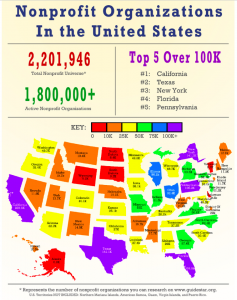In the for-profit sector, mergers and acquisitions are common. However, in the non-profit sector, mergers and acquisitions are hardly discussed, often have a negative connotation and seen as a “last option” when non-profits are in distress. Relatively few non-profits are using mergers and acquisitions in a strategic way to strengthen their effectiveness, spread best practices, expand reach, and be cost-effective. Based on the increasing number of non-profits, more public sector organizations should consider a merger or organizational realignment.
According to recent data from the National Center on Charitable Statistics (NCCS), nearly 1.6 million non-profit organizations w ere registered with the Internal Revenue Service (IRS). This number continues to grow annually with an estimation of 30,000 new non-profit organizations being created each year in the United States, which is about 1 nonprofit for every 175 Americans!
ere registered with the Internal Revenue Service (IRS). This number continues to grow annually with an estimation of 30,000 new non-profit organizations being created each year in the United States, which is about 1 nonprofit for every 175 Americans!
Many of these new non-profit organizations share similar missions with existing organizations. As a result, there is a growing increase in duplicating efforts and competing for limited funds and clients. Non-profits are having to work harder, and sometimes in competition with similar organizations, to raise funds and recruit clients for services… chasing a smaller and smaller piece of the proverbial “pie” of available resources and funding that exist. This environment of increasing non-profits has resulted in a rising trend of stagnating (or failing) organizations, ultimately diminishing the potential to accelerate impact.
By continually forming new nonprofits rather than evaluating existing organizations to modify or support, can threaten the future viability of the non-profit sector. It is expensive and time consuming to build any sort of basic infrastructure, to say nothing of doing actual program work. What if instead of duplicating services and risking inefficiency, non-profit organizations leveraged partnerships through shared, transferred, or combined services, resources or programs?
Benefits of a Merger or Organizational Restructure:
- Expand geographic reach
- Expand programming (either the range/scope of programs offered, or the numbers served)
- Increase cost efficiency
- Develop new skills
- Increase funding
There are several types of strategic restructuring that goes beyond simple collaboration to bringing organizations into more formal and long-lasting forms of partnership. In some cases, realignments are mergers of relatively equal organization; in others, smaller non-profits are folded into larger ones.
Common Types of Organizational Restructures:
- Administrative consolidation: Sharing, exchanging, or contracting of administrative functions to support the administrative efficiency of an organization. For example, one organization serves as the fiscal agent of another organization.
- Acquisition: Acquiring one organization into an existing organization. For example, a prevention program is acquired by a residential treatment program.
- Consolidation: Combining two separate organizations into a single new entity. For example, two separate school corporations forming a new consolidated school corporation.
- Joint programming: Launching and managing of one or more programs together. For example, two non-profits coming together to offer a combined summer camp program.
- Joint venture corporation: Creating a new organization with at least one other organization with a shared common purpose. A joint venture may include a cross-sector joint venture between a non-profit and for-profit organization.
- Merger: Combining all programmatic and administrative functions of two or more organizations. For example, a mental health agency and multi-service agency merge to create a new and more comprehensive non-profit.
- Program transfer: Separating one or more of a non-profit’s programs and transferring it to another organization. For example, a suicide/ crisis line program is transferred from a 211 agency to a mental health agency.
The process of considering a merger or other organizational restructure can be a political and emotional decision for all involved, so it is helpful to have a third-party individual or organization like a consultant facilitate the discussion.Stay tuned for the next blog in this series about how we worked with two organizations to facilitate consensus on their decision to restructure and steps you can apply!
In the meantime, if you have any questions about mergers and partnerships please contact us.
Some of this information was adapted from MergeMinnesota: Nonprofit merger as an opportunity for survival and growth.
